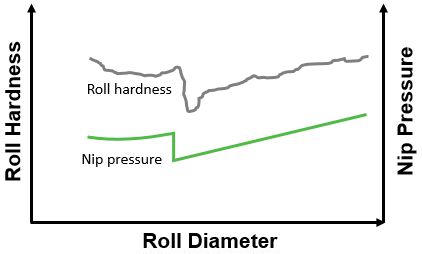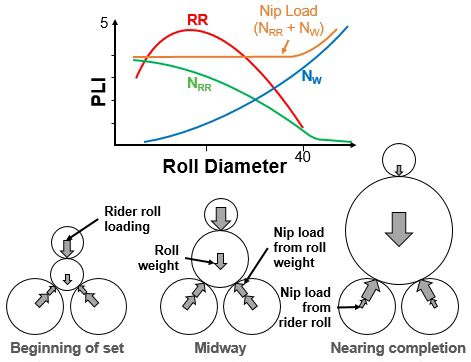Winding principles part 2 - effect and elements of nip pressure
Dec 6, 2016
This article is the second in a short series which explains how web tension, rider roll pressure, and drum torque ratio affect roll quality. The previous article presented an overview, then the tension control variable. This article will discuss nipload.
Rider roll pressure
In the discussion that follows, the term rider roll pressure refers to the downward pressure exerted by the weight of the rider roll on the paper rolls. Rider roll relief pressure refers to the hydraulic pressure in the relief cylinders, which helps support the weight of the rider roll, thereby reducing the downward pressure on the paper rolls.
Indirect action
Although Valmet's technical studies have found that rider roll pressure has an effect on the hardness of shipping rolls, the relationship is neither simple nor direct. Instead, the rider roll pressure acts together with the weight of the shipping rolls to influence the nip pressure between the shipping rolls and the drums. The drum nip pressure, in turn, helps the drums transfer their torque to the shipping rolls, thereby influencing roll hardness.

Figure 4 Effect of nip pressure on roll hardness
Drum nip pressure
The drum nip pressure can be changed at any point in the winding process by altering the rider roll pressure, but the variable that matters is the drum nip pressure, not the rider roll pressure. Before changing the rider roll pressure in an attempt to alter the drum nip pressure, consider the following.
Changes in the nip pressure between the shipping rolls and drums can create unwanted changes in roll hardness. While it's true in general that greater drum nip pressure leads to harder rolls, the relationship between drum nip pressure and roll hardness is very complex.
Winding Pocket
The relationship between drum nip pressure and shipping roll hardness is further complicated by the fact that the shipping rolls start out small, wedged into the winding pocket between the drums; later, as the shipping rolls become larger, they ride higher on the drums. The changing geometry between the shipping rolls and the drums creates changes in the way drum nip pressure affects roll hardness. By maintaining drum nip pressure at a constant level, however, you can prevent unwanted changes in roll hardness.

Figure 5 Elements of nip load as the roll builds in the winding pocket
Maintaining drum nip pressure at a constant level would be difficult, if it weren't for the rider roll relief programs built into the winder control system.
General principle
Toward the end of the set, there will be no way to avoid the high drum nip pressure associated with the weight of the finished rolls. So, if drum nip pressure is to remain constant throughout the winding process, it will have to be kept at a high level right from the beginning. That way, the torque from the drums will be transferred to the shipping rolls equally well at all stages in the process.
Safety function
The purpose of the rider roll is to add downward pressure to the rolls, gradually changing that pressure in order to maintain a constant drum nip pressure at all times. The rider roll also performs a safety function, helping to keep the roll set in place on the drums. For that reason, relief pressure is never allowed to actually lift the rider roll off the paper rolls.
Pressure plus weight
At the beginning of the roll set, the downward pressure of the rider roll makes up for the lighter weight of the rolls. Together, the rider roll pressure and the weight of the rolls yield a constant nip pressure between the rolls and the drums.
Generally speaking, as the shipping rolls get larger and start to weigh more, the downward pressure exerted by the rider roll can be decreased. But this generalization doesn't apply to the very beginning of the winding process.
Beginning of set
At the very beginning of the winding set, the downward pressure of the rider roll need not be as great as the light weight of the rolls would seem to call for, since the rolls are wedged into the winding pocket between the drums. The geometry of this pocket is such that smaller amounts of rider roll pressure yield the necessary drum nip pressure.
As the rolls rise up out of the winding pocket and sit more directly on top of the drums, the rider roll pressure has to increase, even though the paper rolls weigh more than when they were wedged between the drums. Once the rolls have finished rising out of the pocket and are winding above the drums, the rider roll pressure can be steadily lessened as the weight of the rolls continues to increase.
Midway to completion
Now let's look at a set of 48 inch rolls midway to completion. At this point, the rider roll pressure and the weight of the rolls are making equal contributions to the drum nip pressure. Together, the two downward forces create the same drum nip pressure that will be created by the weight of the rolls alone toward the end of the set.
Near completion
When the rolls near completion, the rider roll is fully relieved. The weight of the rider roll is being supported primarily by the hydraulic pressure in the relief cylinders, rather than by the paper rolls. As a result, the downward pressure of the rider roll is minimized, and has little effect on the drum nip pressure. The drum nip pressure remains approximately the same as it has throughout the winding, though, because the weight of the shipping rolls is sufficient at this point to create the necessary drum nip pressure.
Automatic programs
The factors presented here have all been taken into account in the design of the winder automatic rider roll relief programs. Each program is designed to create a constant drum nip pressure approximately equal to the pressure that will be created at the end of the set for a given size of finished rolls.
Each program automatically adjusts the rider roll relief pressure as the shipping rolls increase in diameter and weight.
Varying Pressure
The relief pressure decreases during the first part of the set, allowing the weight of the rider roll to press down harder on the rolls as the rolls rise out of the winding pocket and begin resting on top of the drums. Then, as the rolls continue to increase in diameter and weight, the rider roll relief pressure increases also, to help lift the rider roll and prevent it from pressing too heavily on the paper rolls. Toward the end of the set, the rider roll will be fully relieved, which means the relief pressure has been raised to the point where most of the rider roll weight is supported by the hydraulic relief cylinders rather than by the paper rolls.
This article series will conclude with a discussion of drum torque and its effect on roll hardness. For more information on winding principles and how to wind a perfect roll, contact your Valmet representative.